Why Has The World Population Sharply Increased Since The Late 1800's?

Absolute increase in global human being population per year[i]
Population growth is the increase in the number of people in a population. Global human population growth amounts to around 83 million annually, or 1.1% per year.[two] The global population has grown from i billion in 1800 to 7.9 billion in 2022.[three] The UN projected population to keep growing, and estimates have put the total population at 8.6 billion past mid-2030, ix.8 billion by mid-2050 and eleven.2 billion by 2100.[4] However, some academics outside the Un accept increasingly developed man population models that account for additional downward pressures on population growth; in such a scenario population would peak earlier 2100.[v]
Globe human population has been growing since the end of the Blackness Death, around the year 1350.[half dozen] A mix of technological advancement that improved agricultural productivity and sanitation and medical advancement that reduced mortality increased population growth. In some geographies, this has slowed through the process called the demographic transition, where many nations with high standards of living have seen a pregnant slowing of population growth. This is in direct contrast with less adult contexts, where population growth is withal happening.[7] Globally, the rate of population growth has declined from a peak of 2.two% per year in 1963.[8] The global human population is projected to peak during the mid-21st century and pass up by 2100.[9]
Population growth aslope increased consumption is a commuter of environmental concerns, such equally biodiversity loss and climate change, due to resources utilised in human evolution.[ten] International policy focused on mitigating the bear upon of human being population growth is concentrated in the Sustainable Development Goals which seek to ameliorate the standard of living globally while reducing the bear on of lodge on the environment.
| Years passed | Yr | Popular. (billions) |
|---|---|---|
| – | 1800 | 1 |
| 127 | 1927 | 2 |
| 33 | 1960 | 3 |
| 14 | 1974 | 4 |
| 13 | 1987 | 5 |
| 12 | 1999 | 6 |
| 12 | 2011 | vii |
| 12 | 2023* | viii |
| 14 | 2037* | 9 |
| 18 | 2055* | 10 |
| 33 | 2088* | xi |
| - | 2150* | 12 |
| *World Population Prospects 2022 (United Nations Population Partitioning) | ||
History [edit]
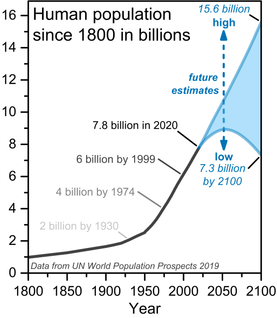
Globe human being population estimates from 1800 to 2100, with estimated range of hereafter population after 2022 based on "high" and "depression" scenarios. Data from the United nations projections in 2022.
World population has been ascent continuously since the end of the Black Decease, effectually the yr 1350.[vi] Population began growing quickly in the Western world during the industrial revolution. The near significant increment in the world's population has been since the 1950s, mainly due to medical advancements[11] and increases in agricultural productivity.[12]
Haber process [edit]
Due to its dramatic impact on the human power to abound nutrient, the Haber process, named after one of its inventors, the High german chemist Fritz Haber, served as the "detonator of the population explosion", enabling the global population to increment from 1.6 billion in 1900 to 7.7 billion by November 2022.[thirteen]
Thomas McKeown hypotheses [edit]
Some of the reasons for the "Modern Rise of Population"[14] were particularly investigated past the British health scientist Thomas McKeown (1912-1988). In his publications, McKeown challenged four theories almost the population growth:
- McKeown stated that the growth in Western population, particularly surging in the 19th century, was non and then much caused past an increase in fertility, but largely by a decline of mortality especially of childhood bloodshed followed by infant bloodshed,[15] [16]
- The turn down of mortality could largely be attributed to rising standards of living, whereby McKeown put most emphasis on improved nutritional status,
- His near controversial idea, or at least his most disputed idea, was that he questioned the effectiveness of public health measures, including sanitary reforms, vaccination and quarantine,[17]
- The sometimes fierce disputes that his publication provoked effectually the "McKeown thesis" take overshadowed his more of import and largely unchallenged argument that curative medicine measures played little office in mortality decline, not only prior to the mid-20th century[15] but also until well into the 20th century.[18]
Although the McKeown thesis has been heavily disputed, recent studies accept confirmed the value of his ideas.[19] His work is pivotal for present day thinking nigh population growth, birth control, public health and medical care. McKeown had a major influence on many population researchers, such as wellness economists and Nobel prize winners Robert W. Fogel (1993) and Angus Deaton (2015). The latter considered McKeown as "the founder of social medicine".[20]
Growth rate models [edit]
The "population growth rate" is the rate at which the number of individuals in a population increases in a given time menstruum, expressed as a fraction of the initial population. Specifically, population growth rate refers to the modify in population over a unit fourth dimension period, often expressed as a per centum of the number of individuals in the population at the beginning of that period. This tin be written as the formula, valid for a sufficiently pocket-size fourth dimension interval:
A positive growth rate indicates that the population is increasing, while a negative growth rate indicates that the population is decreasing. A growth ratio of cypher indicates that in that location were the same number of individuals at the starting time and terminate of the period—a growth charge per unit may be zippo even when there are significant changes in the birth rates, decease rates, immigration rates, and age distribution betwixt the two times.[21]
A related measure is the net reproduction rate. In the absence of migration, a net reproduction rate of more than 1 indicates that the population of females is increasing, while a net reproduction rate less than 1 (sub-replacement fertility) indicates that the population of females is decreasing.
Most populations do not abound exponentially, rather they follow a logistic model. Once the population has reached its carrying capacity, it will stabilize and the exponential curve will level off towards the carrying capacity, which is usually when a population has depleted almost its natural resource.[22] In the globe human population, growth has been following a linear trend throughout the last few decades.[viii]
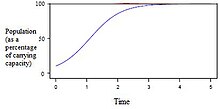
The logistic growth of a population.
Logistic equation [edit]
The growth of a population tin can often be modelled past the logistic equation[23]
where
Equally it is a separable differential equation, the population may be solved explicitly, producing a logistic part:
- ,
where and is the initial population at time 0.
Population growth rate [edit]
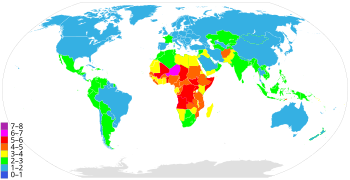
A globe map showing global variations in fertility charge per unit per woman co-ordinate to the CIA World Factbook'southward 2022 data
| 7–eight children 6–7 children | five–6 children four–5 children | three–4 children 2–3 children | one–2 children 0–1 children |
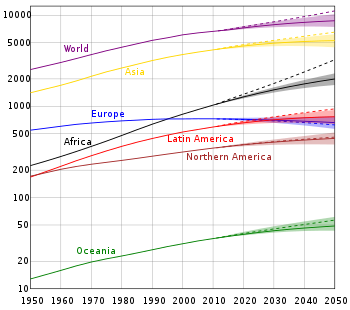
Estimates of population evolution in different continents between 1950 and 2050 according to the United nations. The vertical axis is logarithmic and is in millions of people. (2011)
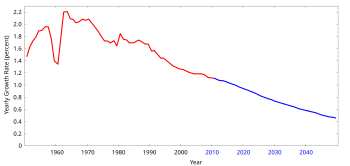
World population growth rates between 1950 and 2050
The earth population growth rate peaked in 1963 at 2.two% per year and subsequently declined.[8] In 2022, the estimated almanac growth rate was one.ane%.[24] The CIA Earth Factbook gives the world almanac birthrate, mortality rate, and growth rate as ane.86%, 0.78%, and 1.08% respectively.[25] The concluding 100 years accept seen a massive fourfold increase in the population, due to medical advances, lower mortality rates, and an increase in agronomical productivity made possible by the Green Revolution.[26]
The annual increment in the number of living humans peaked at 88.0 1000000 in 1989, then slowly declined to 73.nine 1000000 in 2003, after which it rose once more to 75.2 million in 2006. In 2022, the human population increased by 83 million.[24] By and large, developed nations take seen a decline in their growth rates in recent decades, though almanac growth rates remain higher up ii% in some countries of the Middle East and Sub-Saharan Africa, and too in South Asia, Southeast Asia, and Latin America.[27]
In some countries the population is declining, especially in Eastern Europe, mainly due to low fertility rates, loftier decease rates and emigration. In Southern Africa, growth is slowing due to the loftier number of AIDS-related deaths. Some Western Europe countries might also experience population decline.[28] Japan's population began decreasing in 2005.[29]
The Un Population Division projects globe population to attain 11.2 billion by the finish of the 21st century. The Institute for Health Metrics and Evaluation projects that the global population will acme in 2064 at 9.73 billion and reject to 8.89 billion in 2100. [9] A 2022 study in Science concludes that the global population will reach 11 billion by 2100, with a 70% chance of connected growth into the 22nd century.[thirty] [31] The German language Foundation for Earth Population reported in Dec 2022 that the global human population grows by 2.six people every second, and could attain 8 billion past 2023.[32] [33]
Growth by country [edit]
According to United Nations population statistics, the world population grew past thirty%, or 1.vi billion humans, between 1990 and 2010.[34] In number of people the increase was highest in India (350 million) and China (196 million). Population growth rate was amidst highest in the United Arab Emirates (315%) and Qatar (271%).[34]
| Rank | Country | Population | Annual Growth (%) | |||
|---|---|---|---|---|---|---|
| 1990 | 2010 | 2020 (est.)[35] | 1990–2010 | 2010–2020 | ||
| World | v,306,425,000 | vi,895,889,000 | 7,503,828,180 | 1.3% | 0.8% | |
| 1 | | one,139,060,000 | one,341,335,000 | 1,384,688,986 | 0.8% | 0.iii% |
| 2 | | 873,785,000 | 1,224,614,000 | one,296,834,042 | 1.7% | 0.half-dozen% |
| three | | 253,339,000 | 310,384,000 | 329,256,465 | one.0% | 0.6% |
| iv | | 184,346,000 | 239,871,000 | 262,787,403 | one.3% | 0.9% |
| 5 | | 149,650,000 | 194,946,000 | 208,846,892 | 1.3% | 0.seven% |
| 6 | | 111,845,000 | 173,593,000 | 207,862,518 | 2.2% | 1.8% |
| 7 | | 97,552,000 | 158,423,000 | 203,452,505 | 2.5% | 2.5% |
| 8 | | 105,256,000 | 148,692,000 | 159,453,001 | 1.7% | 0.7% |
| nine | | 148,244,000 | 142,958,000 | 142,122,776 | -0.two% | −0.1% |
| x | | 122,251,000 | 128,057,000 | 126,168,156 | 0.2% | −0.i% |
Many of the earth's countries, including many in Sub-Saharan Africa, the Centre E, Southern asia and South East asia, have seen a sharp ascension in population since the end of the Cold War. The fear is that loftier population numbers are putting farther strain on natural resource, food supplies, fuel supplies, employment, housing, etc. in some of the less fortunate countries. For example, the population of Chad has ultimately grown from half dozen,279,921 in 1993 to 10,329,208 in 2009,[36] further straining its resources. Vietnam, Mexico, Nigeria, Egypt, Ethiopia, and the DRC are witnessing a similar growth in population.
The following table gives some instance countries or territories:
| Country/territory | Population in | Life expectancy in years (2008) | Full population growth from 1960s to 2007-2011 | ||||
|---|---|---|---|---|---|---|---|
| 1967 | 1990 | 1994 | 2002 | 2008 | |||
| | N/A* | N/A* | iii,437,000[37] | four,298,269 | 5,673,520[38] | 61[39] | two,236,520 |
| | 23,457,000*[forty] | 50,974,000* [41] | 54,939,000[37] | 67,673,031(2003) | 79,221,000[42] | 55[39] | 55,764,000 |
| | 14,355,000†[40] | 25,204,000† [41] | 27,361,000†[37] | 38,114,160 (2003)† | 42,272,000†[38] | 50†[39] | 27,917,000 |
| | iii,410,000[40] | 5,679,000[41] | 6,183,000[37] | ix,253,493(2003) | 10,329,208 (2009)[36] | 47[39] | half dozen,919,205 |
| | 3,546,000[40] | 7,732,000[41] | 8,846,000[37] | 10,790,352 (2001) | 15,306,252 (2009)[43] | 44[39] | 11,760,252 |
| | 61,450,000[forty] | 88,500,000[41] | 108,467,000[37] | 129,934,911 | 158,259,000[38] | 47[39] | 96,809,000 |
| | 4,745,000[40] | 8,156,000[41] | x,462,000[37] | 11,340,480 | fourteen,517,176(2010)[44] | 50[39] | 9,772,176 |
| | 1,050,000[40] | 2,025,000 [41] | 2,211,000[37] | ii,667,859 (2003) | 3,291,000 (2009)[36] | 54[39] | 2,241,000 |
| | 3,607,000[40] | 7,327,000[41] | viii,102,000[37] | 9,967,215 | 13,711,597 (2009)[45] | 57[39] | 10,104,597 |
| | 343,000[twoscore] | 861,000[41] | 1,081,000[37] | 1,367,124 (2000) | 1,705,000[38] | 55[39] | 1,362,000 |
| | 11,833,126 (1966)[40] | 25,012,000[41] | 27,325,000 [37] | 32,818,500 (2003) | 34,895,000[42] [46] | 74[39] | 23,061,874 |
| | 16,353,000[40] | 35,562,000[41] | 42,552,000[37] | 55,225,478 (2003) | seventy,916,439 [42] [47] | 54[39] | 54,563,439 |
| | 30,083,419 (1966)[40] | 53,153,000[41] | 58,326,000[37] | 70,712,345 (2003) | 79,089,650 [42] [48] | 72[39] | 49,006,231 |
| (overseas region of France) | 418,000[40] | Due north/A[41] | N/A[37] | 720,934 (2003) | 827,000 (2009) [38] | N/A[39] | 409,000 |
| (British Overseas Territory) | 2,500[twoscore] | N/A[41] | N/A[37] | 2,967 (2003) | 3,140(2010)[49] | N/A[39] | 640 |
| | viii,935,500[40] | 13,173,000[41] | 13,994,000[37] | fifteen,116,435 | 17,224,200 (2011) | 77[39] | 8,288,700 |
| | xix,191,000[40] | 32,987,000[41] | 34,520,000[37] | 41,088,227 | 45,925,397 (2010)[50] | 73[39] | 26,734,397 |
| | 85,655,000[40] | 150,368,000[41] | 153,725,000[37] | 174,468,575 (2000) | 190,732,694 (2010) [51] | 72[39] | 105,077,694 |
| | 45,671,000[40] | 86,154,000[41] | 93,008,000[37] | 103,400,165 (2000) | 112,322,757 (2010)[52] | 76[39] | 66,651,757 |
| | 476,727 (1966)[40] | 765,000[41] | 771,000[37] | 844,330 (2001) | 849,000[46] (2010) | 70[39] | 372,273 |
| | half-dozen,050 (1966)[40] | x,000[41] | Northward/A[37] | 12,329 | 9,322 (2011)[53] | North/A[39] | 3,272 |
| | 1,876,000[xl] | 2,420,000[41] | 2,429,000[37] | 2,695,867 (2003) | 2,847,232[54](2010) | 74[39] | 971,232 |
| | 11,540,764 (1964)[forty] | 17,086,000[41] | 17,843,000[37] | 19,546,792 (2003) | 26,160,361[55] (2010) | 82[39] | 10,066,508 |
| | one,965,500 (1964)[xl] | iii,250,000[41] | 3,414,000[37] | 3,510,484 | 2,986,952 (July 2010 est.)[36] [56] | 78[39] | ane,021,452 |
| | 31,944,000[forty] | 38,180,000[41] | 38,554,000[37] | 38,626,349 (2001) | 38,192,000 (2010)[57] | 75[39] | vi,248,000 |
| | ten,212,000[xl] | x,553,000[41] | 10,261,000[37] | 10,106,017 | 9,979,000 (2010)[58] | 73[39] | -142,000 |
| | 8,226,564 (1965)[40] | viii,980,000[41] | viii,443,000[37] | 7,707,495(2000) | seven,351,234 (2011)[59] | 73[39] | -875,330 |
| | 55,068,000 (1966)[40] | 57,411,000[41] | 58,091,000[37] | 58,789,194 | 62,008,048 (2010)[sixty] | 79[39] | vii,020,048 |
| | 2,884,002 (1966)[twoscore] | 3,503,000[41] | iii,571,000[37] | 3,840,838 (2000) | four,470,700[61] (2010) | 78[39] | 1,586,698 |
| | 720,000,000[40] | 1,139,060,000[41] | 1,208,841,000[37] | one,286,975,468 (2004) | 1,339,724,852 (2010)[62] | 73[39] | 619,724,852 |
| | 98,274,961 (1965)[forty] | 123,537,000[41] | 124,961,000[37] | 127,333,002 | 127,420,000 (2010)[63] | 82[39] | 28,123,865 |
| | 511,115,000[40] | 843,931,000[41] | 918,570,000[37] | 1,028,610,328 (2001) | 1,210,193,422 (2011)[64] | 69[39] | 699,078,422 |
| | i,956,000 (1967)[40] | three,003,000 (1990) [41] | 2,930,000 (1994)[37] | iv,452,732 (2002) | 5,076,700 (2010)[65] | 82 (2008)[39] | iii,120,700 |
| | 24,000 (1967)[40] | 29,000 (1990) [41] | N/A (1994)[37] | 31,842 (2000) | 35,586[66] (2010) | (2008)[39] | 11,586 |
| | viii,716,000 (1967)[40] | x,123,000 (1990) [41] | x,426,000 (1994)[37] | ten,964,020 (2001)[67] | 11,305,118 (2011)[68] | N/A (2008)[39] | 2,589,118 |
| (Danish dependency) | 38,000 (1967)[twoscore] | N/A (1990) [41] | North/A (1994)[37] | 46,345 (2000) | 48,917 (2010) [69] | N/A (2008)[39] | 18,917 |
| | 20,000 (1967)[forty] | 29,000 (1990) [41] | N/A (1994)[37] | 33,307 (2000) | 35,789 (2009)[70] | (2008)[39] | 15,789 |
| | 29,207,856 (1966)[40] | 42,793,000 (1990) [41] | 44,453,000 (1994)[37] | 48,324,000 (2003) | 48,875,000 (2010) [71] | (2008)[39] | xix,667,144 |
| | 12,700,000 (1967)[twoscore] | 21,773,000 (1990) [41] | 23,483,000 (1994)[37] | 22,224,195 (2002) | 24,051,218 (2010)[72] | (2008)[39] | 11,351,218 |
| | 107,200 (1967)[twoscore] | 266,000 (1990) [41] | 280,000 (1994)[37] | 332,844 (2001) | 401,890 (2011)[73] | 76 (2008)[39] | 306,609 |
| | ten,671,000 (1967)[40] | 17,861,000 (1990) [41] | 19,489,000 (1994)[37] | 21,793,293 (2002) | 27,565,821 (2010)[74] | (2008)[39] | 16,894,821 |
| | 32,680,000 (1967)[40] | 57,196,000 (1990) [41] | 59,396,000 (1994)[37] | 60,606,947 (2000)[75] | 63,878,267 (2011)[76] | (2008)[39] | 31,198,267 |
| | 2,520,000 (1967)[40] | 2,701,000 (1990) [41] | 2,915,000 (1994)[37] | iii,727,703[77] (2003) | four,224,000[38] (2009) | - (2008)[39] | |
| | v,600,000 (1967)[twoscore] | 12,116,000 (1990) [41] | 13,844,000 (1994)[37] | 17,585,540 (2003) | 22,457,763 (2011)[78] | -(2008)[39] | |
| | 182,00 (1967)[40] | 503,000 (1990) [41] | 549,000 (1994)[37] | 667,238 (2003) | ane,234,596[79] (2010) | 75 (2008)[39] | |
| | eleven,741,000 (1967)[40] | 16,993,000 (1990) [41] | 17,685,000 (1994)[37] | xix,607,519 (2002) | 20,238,000[46] (2009) | - (2008)[39] | |
| | 6,050,000 (1967)[40] | 6.712,000 (1990) [41] | half dozen,994,000 (1994)[37] | 7,261,200 (2002) | 7,866,500[lxxx] (2010) | - (2008)[39] | |
| | 335,000 (1967)[40] | 381,000 (1990) [41] | 401,000 (1994)[37] | 439,539 (2001) | 511,840 (2011)[81] | - (2008)[39] | |
| | 19,105,056 (1966)[twoscore] | 23,200,000 (1990)[41] | 22,736,000 (1994)[37] | 21,680,974 (2002) | 21,466,174[82] (2011) | - (2008)[39] | |
| (associated state of New Zealand) | 1,900 (1966)[40] | Northward/A (1990)[41] | Due north/A (1994)[37] | two,134 (2002) | one,398 (2009)[83] | Due north/A (2008)[39] | -502 |
| (New Zealand territory) | 5,194 (1966)[40] | N/A (1990)[41] | N/A (1994)[37] | i,445 (2001) | one,416 (2009) | N/A (2008)[39] | -3,778 |
| | 1,876,000 (1967)[xl] | 2,420,000 (1990) [41] | 2,429,000 (1994)[37] | 2,695,867 (2003) | two,847,232[54] (2010) | 74 (2008)[39] | 971,232 |
| | 32,031,000 (1967)[twoscore] | 32,322,000 (1990)[41] | 34,180,000 (1994)[37] | 37,812,817 (2002) | twoscore,091,359 (2010) | 74 (2008)[39] | viii,060,359 |
| | 49,890,660 (1967)[twoscore] | 56,440,000 (1990)[41] | 57,747,000 (1994)[37] | 59,551,000 (2001) | 63,136,180 (2011)[84] | 81 (2008)[39] | |
| | 52,334,000 (1967)[40] | 57,662,000 (1990)[41] | 57,193,000 (1994)[37] | 56,995,744 (2002) | 60,605,053[85] (2011) | lxxx (2008)[39] | |
| | 774,000 (1967)[40] | 1,075,000 (1990)[41] | 1,104,000 (1994)[37] | ane,179,137 (2000) | 1,288,000 (2009)[46] | 75 (2008)[39] | 514,000 |
| | iv,717,000 (1967)[40] | nine,197,000 (1990)[41] | 10,322,000 (1994)[37] | 12,974,361 (2000) | 13,276,517 (2009) | seventy (2008)[39] | viii,559,517 |
| | 8,033,000 (1967)[40] | 10,609,000 (1990)[41] | x,960,000 (1994)[37] | 11,177,743 (2002) | 11,239,363 (2009)[86] | 77 (2008)[39] | |
| | 246,000 (1967)[40] | 255,000 (1990) [41] | 261,000 (1994)[37] | 250,012 (2001) | 284,589 (2010)[36] | 73 (2008)[39] | 18,589 |
| | 131,377 (1967)[40] | 164,000 (1990) [41] | 164,000 (1994)[37] | 178,173 (2003) | 179,000 (2009)[38] | Due north/A (2008)[39] | |
| | vii,765,981 (1967)[40] | viii,559,000 (1990) [41] | eight,794,000 (1994)[37] | 8,920,705 (2002) | ix,354,462 (2009) | 81 (2008)[39] | |
| | iv,664,000 (1967)[xl] | 4,986,000 (1990) [41] | 5,095,000 (1994)[37] | five,175,783 (2002) | 5,374,781 (2010) | N/A (2008)[39] | |
| | nine,440,000 (1967)[forty] | 10,525,000 (1990)[41] | 9,830,000 (1994)[37] | 10,355,824 (2001) | 10,647,763[87] (2011) | Due north/A (2008)[39] | |
| | 7,323,981 (1967)[40] | 7,712,000 (1990) [41] | 8,031,000 (1994)[37] | 8,032,926 (2001) | eight,404,252 (2011) | North/A (2008)[39] | |
| | ane,738,000 (1967)[40] | four,545,000 (1990)[41] | v,225,000(1994)[37] | v,499,074 (2002) | 6,420,000 (2009)[38] | 77 (2008)[39] | |
| | 12,385,000 (1967)[40] | 21,550,000 (1990)[41] | 23,080,000(1994)[37] | 27,949,639 (2002) | 29,496,000 (2010) | 70 (2008)[39] | |
| | 528,000 (1967)[40] | 965,000 (1990) [41] | 1,050,000 (1994)[37] | 1,345,479 (2002) | i,647,000[38] (2009) | 48 (2008)[39] | |
| | v,203,066 (1967)[forty] | ten,020,000 (1990)[41] | 10,674,000 (1994)[37] | 10,766,500 (2003) | 18,498,000[46] [88] (2009) | 38 (2008)[39] | |
| | 277,000 (1967)[40] | 348,000 (1990)[41] | 389,000 (1994)[37] | 474,214 (2000) | 676,000 (2009)[46] | 61 (2008)[39] | |
| | two,505,000 (1967)[twoscore] | 4,736,000 (1990)[41] | 5,246,000 (1994)[37] | 8,500,500 (2002) | 8,791,832 (2009) | 59 (2008)[39] | |
| | 2,770,000 (1967)[40] | four,139,000 (1990)[41] | four,742,000 (1994)[37] | 5,635,967 (2002) | half-dozen,800,000[89] (2011) | 56 (2008)[39] | |
| | 10,500,000 (1967)[40] | xviii,961,000 (1990)[41] | 21,360,000 (1994)[37] | 25,284,463 (2002) | 29,331,000[46] (2009) | - (2008)[39] | |
| | 25,781,090 (1966)[40] | 54,608,000 (1990)[41] | 59,778,000 (1994)[37] | 66,622,704 (2002) | 75,330,000 (2010)[90] | 71 (2008)[39] | 49,548,910 |
| | 20,014,880 (1966)[40] | 26,603,000 (1990)[41] | 29,248,000(1994)[37] | 31,081,900 (2001) | 32,623,490 (2011)[91] | 81 (2008)[39] | |
| | 199,118,000 (1967)[40] | 249,995,000 (1990)[41] | 260,650,00(1994)[37] | 281,421,906 (2000) | 308,745,538 (2010)[92] | 78 (2008)[39] | |
| | 7,931,000 (1967)[40] | 18,795,000 (1990)[41] | 20,621,000 (1994)[37] | 24,227,297 (2002) | 32,369,558 (2009) | 52 (2008)[39] | |
- Notes
- * Eritrea left Federal democratic republic of ethiopia in 1991.
- † Carve up into the nations of Sudan and Due south Sudan during 2022.
- ‡ Japan and the Ryukyu Islands merged in 1972.
- # India and Sikkim merged in 1975.
| Population growth 1990–2012 (%)[93] | |
|---|---|
| Africa | 73.iii% |
| Middle East | 68.two% |
| Asia (excl. Cathay) | 42.8% |
| Communist china | 19.0% |
| OECD Americas | 27.9% |
| Non-OECD Americas | 36.6% |
| OECD Europe | eleven.5% |
| OECD Asia Oceania | 11.1% |
| Not-OECD Europe and Eurasia | -0.eight% |

Nilkhet Mor in Dhaka past Nahid 02. Bangladesh is one of the nigh densely populated countries in the world.
Future population [edit]
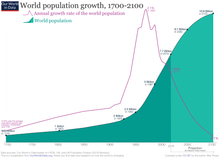
Earth population growth 1700–2100
Population projections are attempts to show how the human population statistics might change in the hereafter.[94] These projections are an important input to forecasts of the population'south impact on this planet and humanity's future well-being.[95] Models of population growth take trends in human development, and use projections into the futurity.[96] These models use trend-based-assumptions almost how populations will respond to economic, social and technological forces to empathize how they will affect fertility and mortality, and thus population growth.[96]
The 2022 projections from the United nations Population Sectionalisation (made earlier the COVID-19 pandemic) show that annual globe population growth peaked at 2.ane% in 1968, has since dropped to 1.1%, and could drib fifty-fifty further to 0.1% by 2100, which would exist a growth rate non seen since pre-industrial revolution days.[97] Based on this, the United nations Population Division projects the globe population, which is 7.viii billion equally of 2022[update], to level out around 2100 at 10.9 billion (the median line),[98] [99] assuming a standing decrease in the global average fertility charge per unit from 2.five births per adult female during the 2022–2020 period to 1.ix in 2095–2100, according to the medium-variant projection.[100] A 2022 projection has the population continuing to grow into the next century.[101]
Yet, estimates outside of the United Nations take put forward culling models based on boosted downward pressure on fertility (such as successful implementation of instruction and family unit planning goals in the Sustainable Development Goals) which could consequence in peak population during the 2060-2070 period rather than later.[96] [102]
According to the UN, about 2-thirds of the predicted growth in population between 2022 and 2050 will take place in Africa.[103] It is projected that l% of births in the 5-year period 2095-2100 volition be in Africa.[104] Other organizations project lower levels of population growth in Africa based specially on improvement in women'due south education and successfully implementing family planning.[105]
Past 2100, the United nations projects the population in Sub-Saharan Africa will reach 3.8 billion, IHME projects 3.1 billion, and IIASA is the lowest at 2.6 billion. In contrast to the United nations projections, the models of fertility adult by IHME and IIASA incorporate women's educational attainment, and in the instance of IHME, also assume successful implementation of family planning.[106]

Earth population prospects, 2022
Considering of population momentum the global population will continue to grow, although at a steadily slower rate, for the residuum of this century, merely the master driver of long-term future population growth volition be the evolution of the global average fertility charge per unit.[100]

Estimated size of human population from x,000 BCE to 2000 CE.
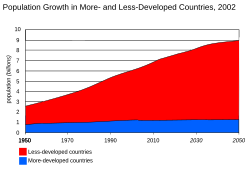
The majority of world population growth today is occurring in less adult countries.
Come across also [edit]
- Demographic history
- Demographic transition
- Density dependence
- Epidemiological transition
- Human population planning
- Irruptive growth
- List of countries by population growth rate
- Population pass up
- Globe population
- Estimates of historical world population
References [edit]
- ^ "Accented increase in global population per twelvemonth". Our Globe in Information. Archived from the original on 28 February 2022. Retrieved 15 February 2022.
- ^ "Earth Population Prospects 2022 – Data Booklet (ST/ESA/SER.A/401)" (PDF). Un Department of Economic and Social Affairs. 2022. p. 3. Archived (PDF) from the original on March vii, 2022. Retrieved April thirteen, 2022.
- ^ "Globe Population 2022". Retrieved 2020-04-01 .
- ^ "World Population Prospects: The 2022 Revision: Fundamental Findings and Advance Tables" (PDF). United Nations Department of Economic and Social Diplomacy, Population Division. p. 2. Archived (PDF) from the original on June 26, 2022. Retrieved January v, 2022.
- ^ Roser, Max (2013-05-09). "Future Population Growth". Our World in Data.
- ^ a b "Black death 'discriminated' between victims". 29 January 2008. Archived from the original on 20 December 2022. Retrieved 2008-11-03 .
- ^ Population Reference Agency. "2013 World Population Factsheet" (PDF). Population Reference Bureau . Retrieved five December 2022.
- ^ a b c Roser, Max; Ritchie, Hannah; Ortiz-Ospina, Esteban (2013-05-09). "World Population Growth". Our World in Data.
- ^ a b Fertility, mortality, migration, and population scenarios for 195 countries and territories from 2022 to 2100: a forecasting analysis for the Global Burden of Disease Study (pdf). Lancet. July 14, 2022. doi:10.1016/S0140-6736(20)30677-2.
- ^ United nations Environment Programme (2021). Making Peace with Nature: A scientific blueprint to tackle the climate, biodiversity and pollution emergencies. Nairobi. https://www.unep.org/resources/making-peace-nature
- ^ Greenwood, B. (19 June 2022). "The contribution of vaccination to global health: past, present and future". Philosophical Transactions of the Majestic Society of London. Series B, Biological Sciences. Vol. 369, no. 1645. Philosophical Transactions of the Royal Society. p. 20130433. doi:10.1098/rstb.2013.0433. PMC4024226. PMID 24821919.
- ^ Armelagos, George J., Alan H. Goodman, and Kenneth H. Jacobs. "The origins of agronomics: Population growth during a menses of declining wellness." Population and Environment 13.i (1991): 9-22.
- ^ Smil, Vaclav (1999). "Detonator of the population explosion" (PDF). Nature. 400 (6743): 415. Bibcode:1999Natur.400..415S. doi:ten.1038/22672. S2CID 4301828.
- ^ McKeown, Thomas (1976). The Modern Rise of Population. London, UK: Edward Arnold. ISBN9780713159868.
- ^ a b McKeown T, Brownish RG (1955). "Medical bear witness related to English population changes in the eighteenth century". Population Studies. nine (2): 119–141. doi:ten.1080/00324728.1955.10404688. JSTOR 2172162.
- ^ McKeown T, Dark-brown RG, Record RG (1972). "An interpretation of the modern ascent of population in Europe". Population Studies. 26 (3): 345–382. doi:10.1080/00324728.1972.10405908. JSTOR 2173815. PMID 11630563.
- ^ McKeown T, Record RG (1962). "Reasons for the Decline of Mortality in England and Wales during the Nineteenth Century". Population Studies. 16 (2): 94–122. doi:10.2307/2173119. JSTOR 2173119.
- ^ McKeown T, Record RG, Turner RD (1975). "An Interpretation of the Decline of Bloodshed in England and Wales during the Twentieth Century". Population Studies. 29 (3): 391–422. doi:x.1080/00324728.1975.10412707. JSTOR 2173935. PMID 11630508.
- ^ Korotayev, A. V.; Malkov, A. S. (2016). "Compact Mathematical Model of the World Organisation Economic and Demographic Growth, ane CE–1973 CE". International Journal of Mathematical Models and Methods in Applied Sciences. x: 200–209.
- ^ Deaton, Angus (2013). The Great Escape. Health, wealth, and the origins of inequality. Princeton and Oxford: Princeton Academy Press. pp. 91–93. ISBN978-0-691-15354-4.
McKeown's views, updated to modernistic circumstances, are still important today in debates betwixt those who recall that health is primarily adamant by medical discoveries and medical treatment and those who wait to the background social conditions of life.
- ^ Association of Public Health Epidemiologists in Ontario Archived 2008-05-22 at the Wayback Machine
- ^ a b Reece, Jane; Urry, Lisa; Cain, Michael; Wasserman, Steven; Minorsky, Peter; Jackson, Robert (2014). Campbell Biology. Pearson.
- ^ Stewart, James; Clegg, Daniel (2012). Cursory Applied Calculus. Brooks/Cole Cengage Learning.
- ^ a b "Earth Population Prospects 2022". Archived from the original on 2022-07-xi.
- ^ "The Globe Factbook". twenty Nov 2022. Retrieved 4 January 2022.
- ^ "BBC NEWS - South Asia - The end of Bharat's green revolution?". 2006-05-29.
- ^ "International Programs". Archived from the original on 2009-07-01.
- ^ UN population projections Archived 2010-10-28 at WebCite
- ^ "Japan sees biggest population autumn". the Guardian. Associated Press. 2009-01-02.
- ^ Carrington, Damien (September 18, 2022). "Earth population to hit 11bn in 2100 – with seventy% chance of continuous rise". The Guardian . Retrieved December xix, 2022.
- ^ Gerland, P.; Raftery, A. E.; Ev Ikova, H.; Li, N.; Gu, D.; Spoorenberg, T.; Alkema, L.; Fosdick, B. K.; Chunn, J.; Lalic, N.; Bay, G.; Buettner, T.; Heilig, G. K.; Wilmoth, J. (September 14, 2022). "World population stabilization unlikely this century". Scientific discipline. 346 (6206): 234–7. Bibcode:2014Sci...346..234G. doi:10.1126/science.1257469. ISSN 1095-9203. PMC4230924. PMID 25301627.
- ^ Hook, Chris (December 20, 2022). "Globe's population set to soar to seven.75 billion people by New year's Eve". 7 News . Retrieved January 2, 2022.
- ^ Silk, John (21 Dec 2022). "World's population to hit seven.75 billion in 2022". Deutsche Welle . Retrieved xiv March 2022.
- ^ a b "World Population Prospects - Population Division - Un". Archived from the original on 2022-05-07. Retrieved 2012-05-28 .
- ^ "East Asia/Southeast Asia :: People's republic of china — The Globe Factbook - Central Intelligence Agency". www.cia.gov . Retrieved 2019-05-15 .
- ^ a b c d e Barbados: People. World Factbook of CIA
- ^ a b c d e f g h i j chiliad l thousand n o p q r due south t u v due west x y z aa ab ac ad ae af ag ah ai aj ak al am an ao ap aq ar as at au av aw ax ay az ba bb bc bd be bf bg bh bi bj bk bl bm bn bo bp bq br bs bt bu bv bw bx The British Collins Longman Student Atlas, the 1996 and in 1998 publications, ISBN 978-0-00-448879-0 for the 1998 edition, ISBN 0-00-448365-0 for the 1996 edition
- ^ a b c d east f g h i "World Population Prospects: The 2008 Revision: Selected Tables: Annex Tables" (PDF). United Nations. 2009. Table A.1. Total Population past Sex in 2009 and Sexual practice Ratio by Country in 2009. Retrieved 2009-03-12 . NB: The preliminary results of the National population census in Republic of guinea-Bissau put the figure at 1,449,230, co-ordinate to email information by the Instituto Nacional de Estudos due east Pesquisa, Bissau.
- ^ a b c d due east f g h i j k fifty m due north o p q r s t u v w x y z aa ab air conditioning advertisement ae af ag ah ai aj ak al am an ao ap aq ar as at au av aw ax ay az ba bb bc bd be bf bg bh bi bj bk bl bm bn bo bp bq br bs bt bu bv bw bx 'Modern School Atlas (96th edition)', ISBN 978-1-84907-013-3.
- ^ a b c d e f 1000 h i j k l g northward o p q r s t u v w ten y z aa ab ac ad ae af ag ah ai aj ak al am an ao ap aq ar as at au av aw ax ay az ba bb bc bd be bf bg bh bi bj bk bl bm bn bo bp bq br bs bt bu bv bw The British Oxford economic atlas of the Earth 4th edition, ISBN 0-19-894107-2
- ^ a b c d east f g h i j k fifty grand due north o p q r south t u v west 10 y z aa ab ac advert ae af ag ah ai aj ak al am an ao ap aq ar as at au av aw ax ay az ba bb bc bd exist bf bg bh bi bj bk bl bm bn bo bp bq br bs bt bu bv bw The British Collins Atlas of the World, the 1993 edition, ISBN 0-00-448038-4
- ^ a b c d Ethiopia Central Statistics Office -- Population Projection for mid-2008 Archived January 5, 2022, at the Wayback Machine
- ^ Primal Intelligence Agency (2009). "Niger". The World Factbook. Retrieved Jan ten, 2010.
- ^ "Mali preliminary 2009 census". Institut National de la Statistique. Archived from the original on April 18, 2010. Retrieved January 12, 2010.
- ^ Key Intelligence Agency (2009). "Senegal". The World Factbook. Retrieved January x, 2010.
- ^ a b c d due east f grand "World Population Prospects, Table A.1" (PDF). United Nations. 2010. Retrieved 2009-03-12 . [ expressionless link ]
- ^ The Earth Factbook- Congo, Democratic Democracy of the. Primal Intelligence Bureau.
- ^ "Central Agency for Population Mobilisation and Statistics — Population Clock (July 2008)". Msrintranet.capmas.gov.eg. Archived from the original on 2010-09-08. Retrieved 2010-08-25 .
- ^ "Falkland Islands (Islas Malvinas)". The World Factbook. CIA. Retrieved 5 March 2010.
- ^ "Departamento Administrativo Nacional de Estadística". Dane.gov.co. Archived from the original on 2022-09-05. Retrieved 2010-08-22 .
- ^ IBGE. Censo 2010: população do Brasil é de 190.732.694 pessoas.
- ^ "INEGI 2010 Demography Statistics". inegi.org.mx. Retrieved 2010-11-25 .
- ^ Central Intelligence Agency (2011). "Republic of nauru". The Earth Factbook. Retrieved 12 Feb 2022.
- ^ a b "The World Factbook". xix Oct 2022.
- ^ "Population clock". Australian Agency of Statistics website. Commonwealth of Australia. Retrieved 12 Apr 2022. The population guess shown is automatically calculated daily at 00:00 UTC and is based on information obtained from the population clock on the date shown in the citation.
- ^ "IFs Forecast - Version 7.00-Google Public Information Explorer".
- ^ "Wzrasta liczba ludności Polski - Wiadomości - WP.PL". Wiadomosci.wp.pl. 2010-07-23. Archived from the original on 2022-10-05. Retrieved 2010-07-27 .
- ^ Hungarian Primal Statistical Function. Retrieved 25 July 2010.
- ^ "Archived copy" (PDF). Archived from the original (PDF) on 2022-09-05. Retrieved 2011-12-31 .
{{cite web}}: CS1 maint: archived copy as title (link) - ^ "Full population at 1 Jan". Eurostat. xi March 2022. Retrieved 29 April 2022.
- ^ "CSO – Population and Migration Estimates April 2010" (PDF). September 2010. Archived from the original (PDF) on xx September 2010. Retrieved 21 September 2010.
- ^ Communiqué of the National Bureau of Statistics of People's Commonwealth of Mainland china on Major Figures of the 2010 Population Census Archived November 8, 2022, at the Wayback Motorcar
- ^ "Statistics Bureau Home Page/Population Estimates Monthly Study".
- ^ "Conditional Population Totals - Census 2022". Indian Census Bureau 2022. Retrieved 2011-03-29 .
- ^ "Population (Mid Year Estimates) & Land Area". Statistics Singapore. 31 August 2010. Archived from the original on 2010-09-fourteen.
- ^ Monaco, The World Factbook, Central Intelligence Agency. Retrieved 7 June 2010.
- ^ "Πίνακας i. Πληθυσμός κατά φύλο και ηλικία" (PDF). National Statistical Service of Hellenic republic: Population census of 18 March 2001. Archived from the original (PDF) on March 25, 2009.
- ^ "Total population". Eurostat. ane January 2010. Retrieved 8 Jan 2010.
- ^ "Archived copy". Archived from the original on 2022-12-10. Retrieved 2015-12-10 .
{{cite web}}: CS1 maint: archived re-create equally championship (link) (Faroese) - ^ Bevölkerungsstatistik 30. Juni 2009 Archived 2022-eleven-fourteen at the Wayback Machine, Landesverwaltung Principality of liechtenstein.
- ^ "총인구, 인구성장률 : 지표상세화면". Index.go.kr. Retrieved 2010-10-29 .
- ^ 한반도 인구 7천400만명 시대 임박. Joins (in Korean). 2009-x-01. Archived from the original on 2010-04-17. Retrieved 2010-04-xiv .
- ^ "Brunei". CIA World Factbook. 2022. Retrieved 2011-01-13 .
- ^ "Laporan Kiraan Permulaan 2010". Jabatan Perangkaan Malaysia. p. iii. Archived from the original on July 8, 2022. Retrieved 31 January 2022.
- ^ "Population and Housing Census 2000, National Statistical Office". Web.nso.get.th. 2000-04-01. Archived from the original on 2022-12-24. Retrieved 2010-04-25 .
- ^ "Archived copy" (PDF). Archived from the original (PDF) on 2022-07-16. Retrieved 2011-07-16 .
{{cite web}}: CS1 maint: archived copy equally title (link) - ^ "Central Intelligence Agency. March 2022 est". Cia.gov. Retrieved 2011-04-23 .
- ^ "Cardinal Intelligence Bureau. March 2022 est". Cia.gov. Retrieved 2011-04-23 .
- ^ "REMARKABLE GROWTH EXPATS OUTNUMBER BAHRAINIS IN 2010 Demography". Bahraini Census 2010. 2010-eleven-28. Archived from the original on February xix, 2022. Retrieved 14 Feb 2022.
- ^ "Population size and population composition". Swiss Federal Statistical Office. Swiss Federal Statistical Role, Neuchâtel. 2010. Archived from the original on 2022-06-28. Retrieved 2011-04-29 .
- ^ "Population: 511 840 habitants au 1er janvier 2022", Le Portail des statistiques: Grand-Duché de Grand duchy of luxembourg, iii May 2022. (in French) Retrieved 4 May 2022.
- ^ "Romania - Population". epp.eurostat.ec.europa.eu. Retrieved 26 May 2022.
- ^ "Niue". The World Factbook. Central Intelligence Agency. Retrieved 2009-07-20 .
- ^ "Population totale par sexe et âge au 1er janvier 2022, France métropolitaine". INSEE (in French). Government of France. Retrieved 20 January 2022.
- ^ "Monthly demographic rest: January–November 2010" (PDF) (in Italian). Istat. 28 March 2022. Archived from the original (PDF) on 24 December 2022. Retrieved 2 April 2022.
- ^ Anuario Estadístico de Republic of cuba 2009. Edición 2010 Archived 2010-07-16 at the Wayback Machine, Oficina Nacional de Estadísticas, República de Cuba. Accessed on November half dozen, 2010. Annotation: An exchange rate of 1 CUC to 1.08 USD was used to convert Gdp.[1]
- ^ Pordata, "Base of operations de Dados Portugal Contemporâneo". Accessed on March 7, 2022.
- ^ "Population Forecast to 2060 by International Futures hosted by Google Public Data Explorer". Retrieved 2011-07-thirteen .
- ^ "Groundwork notes - Laos". US Dept. of State. Retrieved 2011-01-20 .
- ^ "Official Iranian Population clock". Amar.org.ir. Archived from the original on 2022-07-22. Retrieved 2011-07-thirteen .
- ^ "Estimated population of Canada, 1605 to present". Statistics Canada. half dozen July 2009. Retrieved 2011-04-17 .
- ^ "Resident Population Data – 2010". U.Due south. Census Bureau. 2010. Archived from the original on 2022-x-28. Retrieved 2010-12-22 .
- ^ CO2 Emissions from Fuel Combustion Archived 2022-12-02 at the Wayback Machine Population 1971–2014 IEA (PDF Page 74, marked page 72)
- ^ "Population Projections". United states of america Demography Agency.
- ^ Kaneda, Toshiko (June 2022). "Understanding Population Projections: Assumptions Behind the Numbers" (PDF). Population Reference Bureau.
- ^ a b c Roser, Max (2013-05-09). "Future Population Growth". Our World in Data.
- ^ Roser, Max (June eighteen, 2022). "Two centuries of rapid global population growth will come to an finish". Our World in Data.
- ^ "World Population Prospects 2022". United nations, Dept of Economic and Social Affairs. 2022.
- ^ "Globe Population Prospects 2022, Population Data, File: Full Population Both Sexes, Medium Variant tab". United nations Population Division. 2022.
- ^ a b "World Population Prospects 2022, Dept of Economic and Social Affairs, File: Full Fertility". United Nations Population Sectionalization. 2022.
- ^ Gerland, P.; Raftery, A. Eastward.; Ev Ikova, H.; Li, N.; Gu, D.; Spoorenberg, T.; Alkema, L.; Fosdick, B. One thousand.; Chunn, J.; Lalic, N.; Bay, Grand.; Buettner, T.; Heilig, G. Thousand.; Wilmoth, J. (September 14, 2022). "World population stabilization unlikely this century". Scientific discipline. AAAS. 346 (6206): 234–7. Bibcode:2014Sci...346..234G. doi:10.1126/science.1257469. ISSN 1095-9203. PMC4230924. PMID 25301627.
- ^ Vollset, Stein Emil; Goren, Emily; Yuan, Chun-Wei; Cao, Jackie; Smith, Amanda E.; Hsiao, Thomas; Bisignano, Catherine; Azhar, Gulrez S.; Castro, Emma; Chalek, Julian; Dolgert, Andrew J. (2020-10-17). "Fertility, mortality, migration, and population scenarios for 195 countries and territories from 2022 to 2100: a forecasting assay for the Global Burden of Disease Study". The Lancet. 396 (10258): 1285–1306. doi:10.1016/S0140-6736(xx)30677-2. ISSN 0140-6736. PMC7561721. PMID 32679112.
- ^ "Earth Population Prospects 2022, Population Data, File: Population Growth Charge per unit, Median Variant tab". United Nations Population Partition. 2022.
- ^ "World'due south Population is Projected to Nearly Stop Growing by the end of the Century". June 17, 2022.
- ^ Kaneda, Toshiko; Falk, Marissa; Patierno, Kaitlyn (March 27, 2022). "Agreement and Comparison Population Projections in Sub-Saharan Africa". Population Reference Bureau.
- ^ "Agreement and Comparing Population Projections in Sub-Saharan Africa". Population Reference Agency.
External links [edit]
- "Earth Population Prospects". Website of the United Nations Population Sectionalisation. Archived from the original on 2022-07-11.
- "Food Production and Population Growth". Daniel Quinn, Alan D. Thornhill, PhD. Ecofuture. Population and Sustainability Media, Non-fiction.
- "Probabilistic Population Projections, 2nd Revision". Website of the United Nations Population Division. Archived from the original on 2022-10-04.
- "Globe population growth and trends 1950-2050". US Census. Archived from the original on 2010-07-07.
- "Globe population: focus on youth, Annual World Population Data Canvas". Population Reference Bureau.
- "Feeding the Ten Billion-Plants and Population Growth". PGR Newsletter FAO-Bioversity 50.T. Evans. 2000. Cambridge Academy Press. ISBN 0-521-64685-5. Published in Event No. 125, folio 39 to 40 - (5802) characters
Why Has The World Population Sharply Increased Since The Late 1800's?,
Source: https://en.wikipedia.org/wiki/Population_growth
Posted by: ortegoounge1939.blogspot.com







0 Response to "Why Has The World Population Sharply Increased Since The Late 1800's?"
Post a Comment